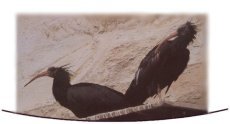Thermit Ibis (Kelaynak) Birds
 From old hand writing documents, it has been determined that Thermit Ibis birds used to live in Europe since 1504. This bird, which was living in Central Europe near the Alps, was first defined by C. Gessner as Corvus Sylvaticus in 1555 in Historia Animalium and some information was given about the birds' life style. Later, it was determined that those birds, which disappeared in Europe, emigrated to Middle East countries and Africa and they still live in these countries.
From old hand writing documents, it has been determined that Thermit Ibis birds used to live in Europe since 1504. This bird, which was living in Central Europe near the Alps, was first defined by C. Gessner as Corvus Sylvaticus in 1555 in Historia Animalium and some information was given about the birds' life style. Later, it was determined that those birds, which disappeared in Europe, emigrated to Middle East countries and Africa and they still live in these countries.
Thermit Ibis that come to Birecik in the middle of February settle down at rocks in the middle of March. After their procreation, their raise their young and in the middle of July they leave Birecik with their young. The reason for these birds to come to Birecik for procreation is thought to be that the calcite mineral in those rocks increased the procreation energy of birds. Thermit Ibis birds are single mate and every year they build their nest and lash out with the same couple. Mature birds are the ones that show their energy to build up a nest. It is necessary to be 5 years old, to become a mature bird. Their average life period is 25-30 years.
In the beginning of 1950, the number of Thermit Ibis was more than 1000, there had been a specific decrease in the number of birds since 1954.
Destruction of natural feeding environment of these birds with overuse of agricultural insecticide chemicals, hunting of these birds by the hunters in their long immigration period and cold weather conditions are the main reasons for the decrease of Thermit Ibis birds. Thermit Ibis birds follow the Lebanon - Israel way and the River Nil or Red Sea coast and cannot be observed at those places.
In order to prevent the decrease in number and disappearing of the generation, Thermit Ibis Procreation Station was established in Birecik by the Generate Directorate of Forestry of the Ministry of Agriculture, Forestry and Rural Affairs in 1972. In this station, first of all two mature and nine young Thermit Ibis birds were captured by net and put into a cage, and then production started in 1977. The birds under protection are fed with meat without fat, planed carrot, boiled egg and mixture of fodder.
In February 1996, 52 Hermit Ibis birds set free from procreation station to reproduction in nature. After the reproduction season, the total number reached to 75 with 23 young birds. 4 of them are given to Istanbul Bayramoğlu Zoo, 5 of them are given to Atatürk Orman Çiftliği, 13 of them immigrated and 45 of them are still living in procreation station.
Birecik people consider Hermit Ibis birds which they regionally call "Keçelaynak" holy. Arrival of Hermit Ibıs birds to Birecik in the middle of February is interpreted by Birecik people as a sign of spring. In recent years, "Hermit Ibıs Festival" is being organized in Birecik for these birds.